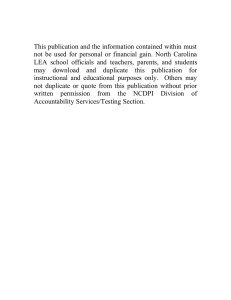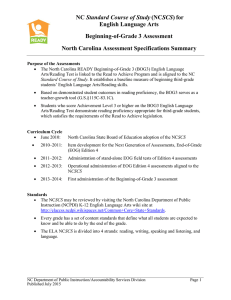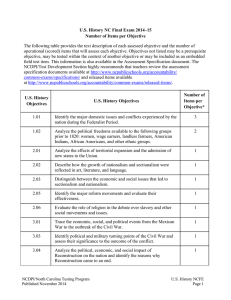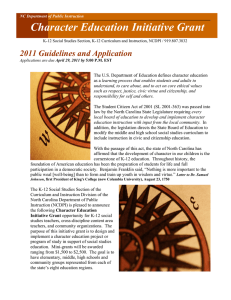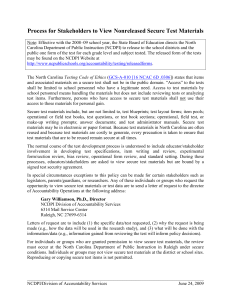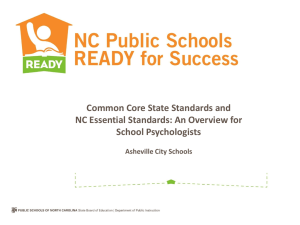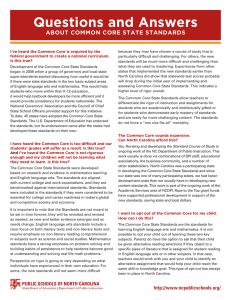2015 Read to Achieve Test Grade 3 English Language Arts/Reading
advertisement
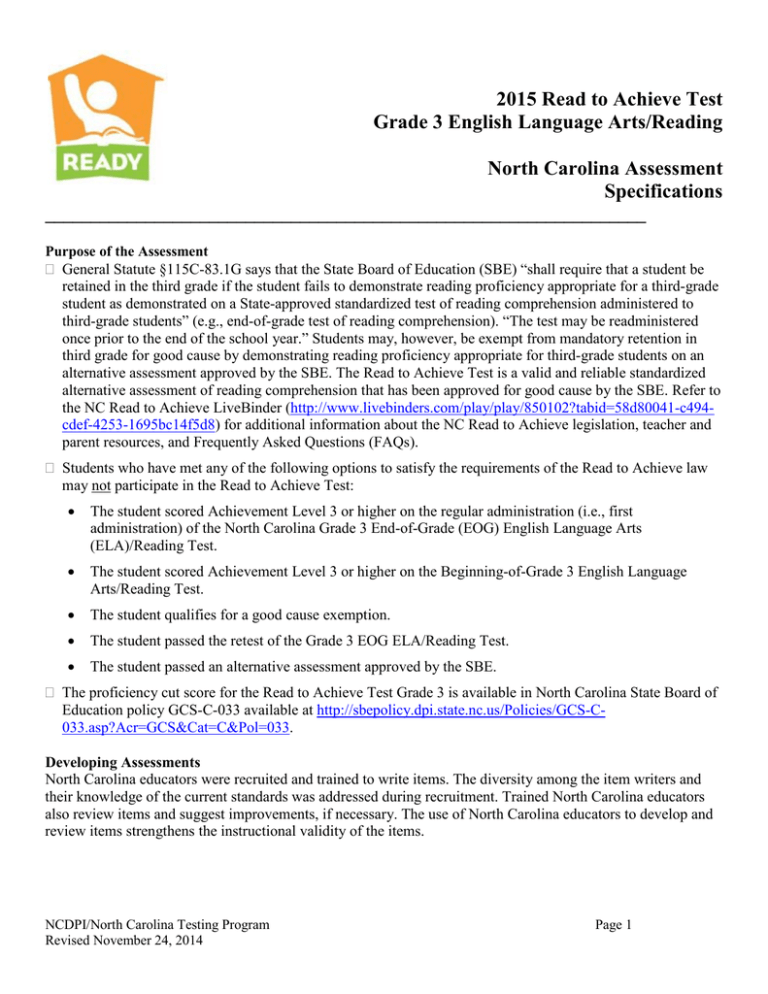
2015 Read to Achieve Test Grade 3 English Language Arts/Reading North Carolina Assessment Specifications __________________________________________________________________ Purpose of the Assessment General Statute §115C-83.1G says that the State Board of Education (SBE) “shall require that a student be retained in the third grade if the student fails to demonstrate reading proficiency appropriate for a third-grade student as demonstrated on a State-approved standardized test of reading comprehension administered to third-grade students” (e.g., end-of-grade test of reading comprehension). “The test may be readministered once prior to the end of the school year.” Students may, however, be exempt from mandatory retention in third grade for good cause by demonstrating reading proficiency appropriate for third-grade students on an alternative assessment approved by the SBE. The Read to Achieve Test is a valid and reliable standardized alternative assessment of reading comprehension that has been approved for good cause by the SBE. Refer to the NC Read to Achieve LiveBinder (http://www.livebinders.com/play/play/850102?tabid=58d80041-c494cdef-4253-1695bc14f5d8) for additional information about the NC Read to Achieve legislation, teacher and parent resources, and Frequently Asked Questions (FAQs). Students who have met any of the following options to satisfy the requirements of the Read to Achieve law may not participate in the Read to Achieve Test: • The student scored Achievement Level 3 or higher on the regular administration (i.e., first administration) of the North Carolina Grade 3 End-of-Grade (EOG) English Language Arts (ELA)/Reading Test. • The student scored Achievement Level 3 or higher on the Beginning-of-Grade 3 English Language Arts/Reading Test. • The student qualifies for a good cause exemption. • The student passed the retest of the Grade 3 EOG ELA/Reading Test. • The student passed an alternative assessment approved by the SBE. The proficiency cut score for the Read to Achieve Test Grade 3 is available in North Carolina State Board of Education policy GCS-C-033 available at http://sbepolicy.dpi.state.nc.us/Policies/GCS-C033.asp?Acr=GCS&Cat=C&Pol=033. Developing Assessments North Carolina educators were recruited and trained to write items. The diversity among the item writers and their knowledge of the current standards was addressed during recruitment. Trained North Carolina educators also review items and suggest improvements, if necessary. The use of North Carolina educators to develop and review items strengthens the instructional validity of the items. NCDPI/North Carolina Testing Program Revised November 24, 2014 Page 1 Curriculum and Assessment Cycle June 2010: North Carolina State Board of Education adoption of the NC Standard Course of Study. 2013–2014: Operational administration of the Read to Achieve Test Grade 3. 2014–15: Second operational administration of the Read to Achieve Test Grade 3. Prioritization of Standards Members of the Test Development section of the North Carolina Department of Public Instruction (NCDPI) invited teachers to collaborate and develop recommendations for a prioritization of the standards indicating the relative importance of each standard, the anticipated instructional time, and the appropriateness of the standard for the multiple-choice item format. Table 1 describes the percentage range of total score points that will appear on the test. The test will consist of only multiple-choice (MC) items. The table of test specification weights describe the percent of total score points, rather than the percent of total items. Table 1. Test Specification Weights for the Read to Achieve Test Grade 3 Domain Standards Percent of Total Score Points Reading for Literature RL.1–RL.4 35–40% Reading for Information RI.1–RI.8 40–45% Language L.4, L.5 20–25% Total 100% Cognitive Rigor The test items will require students to read, comprehend, and recall information. Also, students are expected to apply concepts and skills. Types of Items and Supplemental Materials The test will consist of four-response-option multiple-choice (MC) items. The test will consist of selections drawn from works of literature, which includes short story and poetry, or informational texts, drawn from the domains of History/Social Studies or Science/Technology. A released form for the EOG ELA/Reading Grade 3 Test is available at http://www.ncpublicschools.org/accountability/testing/releasedforms. Released forms may be used by school systems to help acquaint students with items. These materials must not be used for personal or financial gain. Test Structure and Test Administration Time The Read to Achieve Test was built using the same pool of items developed for the End-of-Grade ELA/Reading Grade 3 Test. However, each original selection is divided into two separate texts for the Read to Achieve Test. The selections are divided so that one part does not depend upon the other and each section of the text has its own set of unique items. It was a solution for balancing the complexity and length of the new passages aligned to the standards and the reading load for grade 3 students. Psychometrically this “chunking” design allowed the NCDPI/Test Development Section to use the selections that were field tested as full-length with their accompanying items and allowed us to add additional multiple-choice items to the assessment without adding additional reading selections. Additional items were added because the Read to Achieve Test does not include embedded field test items. For example: The standard full-length selection may have 6-8 accompanying items. A “chunked” selection used on the Read to Achieve Test may have 4-5 items. This design ensures students are able to complete the assessment in the provided time. The Read to Achieve Test will contain 44 four-response-option multiple-choice items. The test will not contain field test items. All item responses are scored and included in the student’s total score. NCDPI/North Carolina Testing Program Revised November 24, 2014 Page 2 The NCDPI requires all students be allowed ample opportunity to complete the Read to Achieve Test. However, no administration may exceed the maximum testing time of three and one-half hours (except for those involving students with documented special needs requiring accommodations, such as Scheduled Extended Time). Students are given 160 minutes to answer all items. The estimated test administration time of 160 minutes is the time that the NCDPI estimates it will take for nearly all students to complete the Read to Achieve Test. Students should monitor the clock to ensure they allow themselves adequate time to respond to all test questions. Students who complete the test before the scheduled time is over must be provided with the option to read novels or other non-textbook (e.g., magazines) while waiting for other students to finish the test. Appendix A shows the number of items for each standard assessed by the 2014–15 Read to Achieve Test. Test Cycle and Delivery Mode The Read to Achieve Test may be administered to students at grade 3 who failed to demonstrate reading proficiency appropriate for a third-grade student on the regular administration (i.e., first administration) of the EOG Reading Assessment. The Read to Achieve Test may be administered to eligible students (1) during the last ten days of the school year, (2) at the end of reading camp on a day designated by the local education agency (LEA), and (3) before the November 1 mid-year promotion for students placed in the 3/4 transitional class or the Grade 4 accelerated class. The Grade 3 Read to Achieve Test is designed for a paper/pencil administration. NCDPI/North Carolina Testing Program Revised November 24, 2014 Page 3 Appendix A Read to Achieve Test Grade 3 Number of Items by Standard The following table shows the number of operational test items for each objective. ELA/Reading Grade 3 Standard RL.1 (Reading: Literature) RL.2 RL.3 RL.4 L.4.a (Language) L.5.a RI.1 (Reading: Informational Text) RI.2 RI.3 RI.4 RI.7 RI.8 NCDPI/North Carolina Testing Program Revised November 24, 2014 Number of Items Per Standard 5 3 3 5 7 3 5 3 4 1 3 2 Page 4
